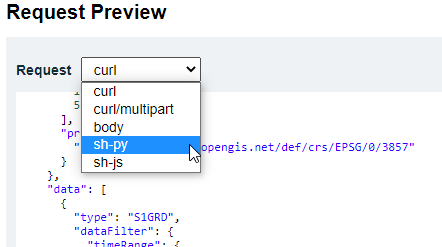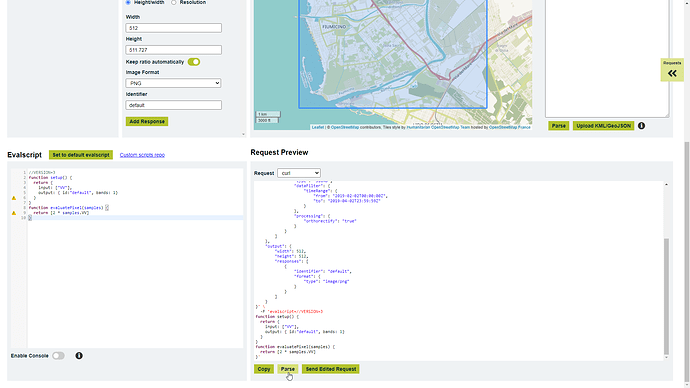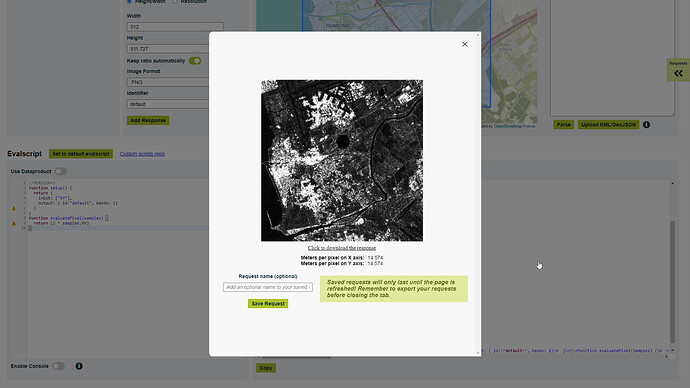hello everyone,
I want to work with sentinel 1A data
Is there an example to follow please!
Hi there @Maryem ,
You can find example requests for Sentinel-1 GRD in our official documentation.
A nifty way to adjust the example requests to your needs, is to use our Requests Builder!
Simply copy the example curl request, paste it into the Request Preview panel and click the Parse button at the bottom. All parameters will be adjusted, based on the parsed request.
Now you can adjust the Evalscript and parameter settings from the example request to your needs and send the request.
A very convenient feature of the Request Preview panel is that it can display the created request in different formats. For example, this enables you to integrate the tested request in your Python workflow using our Sentinel Hub Python package.

Have fun exploring,
Max
Thank you so much
But I want to draw your attention that I want to download radar images specific to my area of interest with a feature extraction (backscatter coefficient) that I will use to train my machine learning model .
So I need an example like the example of land use land cover of slovinia but this time with sentinel 1A data .
Hi @Maryem ,
Thank you for providing more information about your specific use case.
We currently don’t have any eo-learn examples that utilise Sentinel-1 data.
Please note that we cannot provide whole workflows for every use case example.
However, if you decide to push forward with this and try to adapt parts of the provided Sentinel-2 example to use Sentinel-1 data instead, we are very willing to help you along the way. 
I suggest you post specific steps that throw errors when adapting the changes, like you have done in previous forum threads.
Best,
Max
Hello,
Thank you so much for your answer.
I Think that I 'am facing this problem because of the configuration sentinelHubInputTask. Also, I have to extract the backscatter’s coefficient and I don’t know how it can be done!
I suggest you try SentinelHubEvalscriptTask, where you have more influence into what output you want to get. Something along the lines:
s1_evalscript = """
//VERSION=3
function setup() {
return {
input: [{
bands:["VV", "VH", "dataMask"],
metadata: ["bounds"]
}],
output: [
{
id: "VV",
bands: 1,
sampleType: "FLOAT32",
nodataValue: NaN,
},
{
id: "VH",
bands: 1,
sampleType: "FLOAT32",
nodataValue: NaN,
},
{
id: "MASK",
bands: 1,
sampleType: "UINT8",
nodataValue: 0,
}
]
};
}
function evaluatePixel(samples) {
return {
VV: [samples.VV],
VH: [samples.VH],
MASK: [samples.dataMask]
};
}
"""
s1_processing = {
"backCoeff": "GAMMA0_TERRAIN",
"orthorectify": True,
"demInstance": "COPERNICUS_30",
}
s1_input = SentinelHubEvalscriptTask(
features={
FeatureType.DATA: {'VV', 'VH'},
FeatureType.MASK: {'MASK'}
},
evalscript=s1_evalscript,
data_collection=DataCollection.SENTINEL1,
resolution=10,
time_difference=datetime.timedelta(minutes=120),
aux_request_args={'processing': s1_processing},
max_threads=5
)
s1_eopatch = s1_input.execute(bbox=bbox, time_interval=time_interval)
of course, providing your bounding box and time interval.
You can have a look at Sentinel-1 docs and examples to see how you can tweak the processing parameters and evalscript.
Best,
Matej

